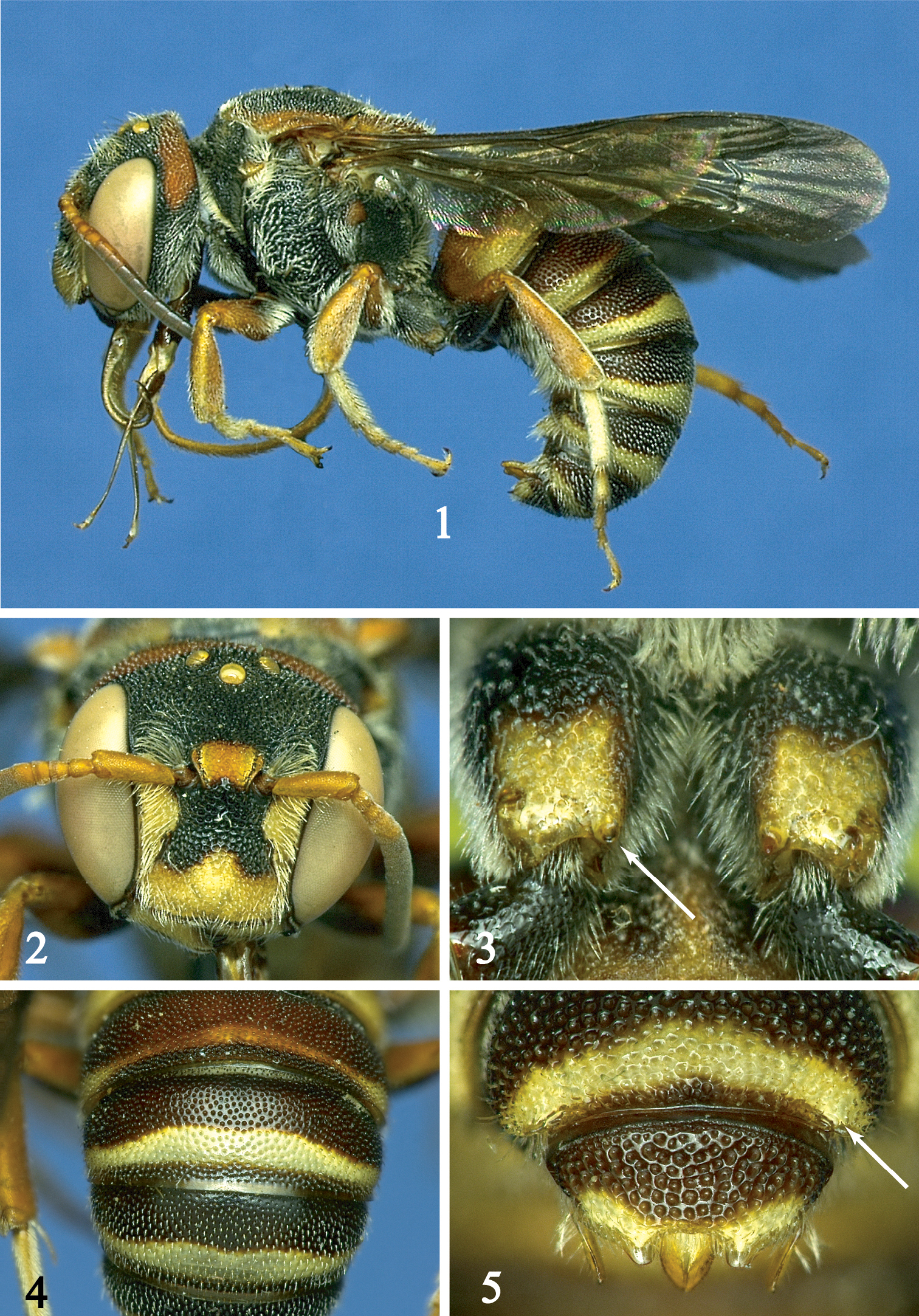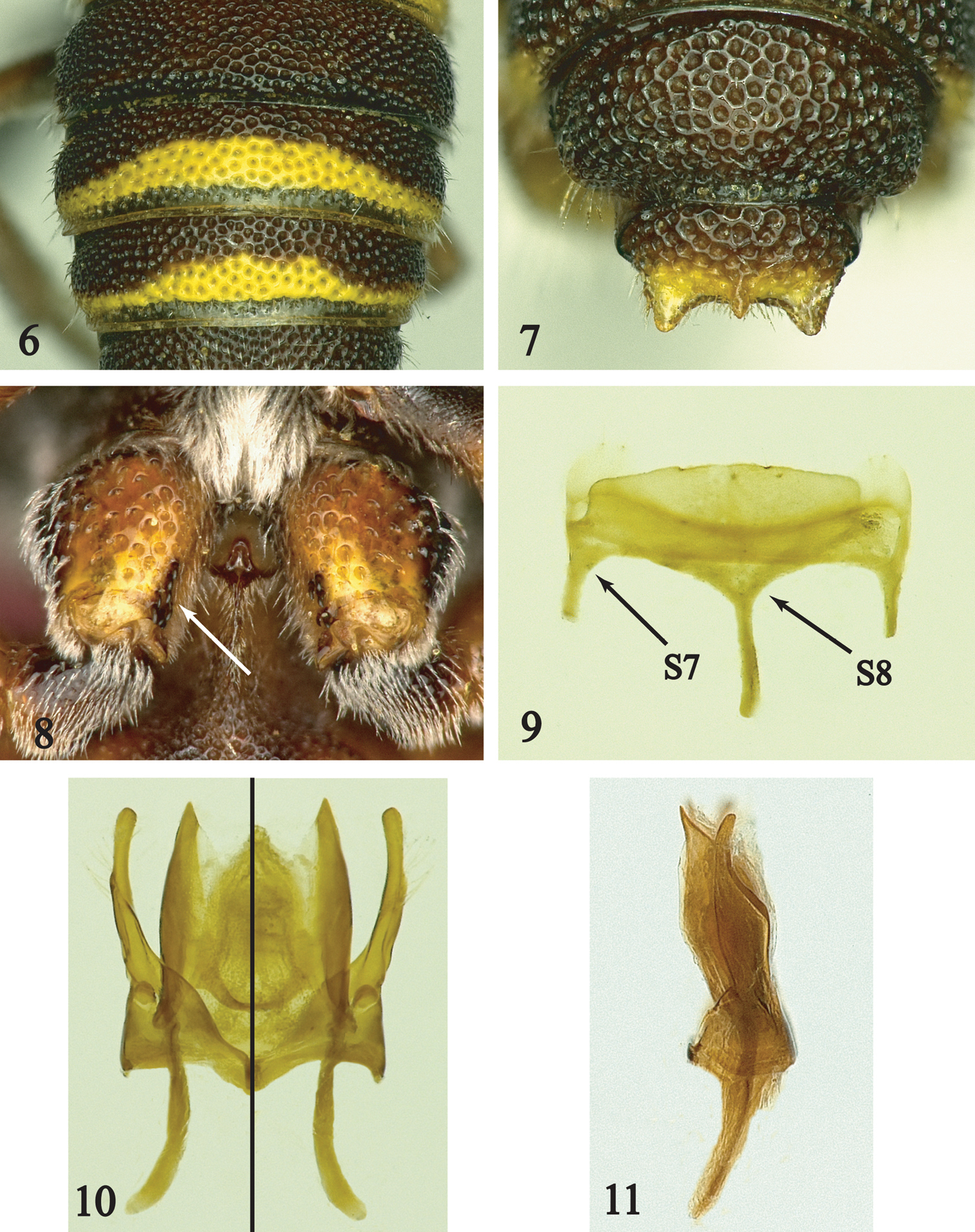






(C) 2011 Victor H. Gonzalez. This is an open access article distributed under the terms of the Creative Commons Attribution License, which permits unrestricted use, distribution, and reproduction in any medium, provided the original author and source are credited.
For reference, use of the paginated PDF or printed version of this article is recommended.
As part of ongoing investigations on anthidiine bees, the type of Anthidium albitarse Friese was found to be conspecific with one of the two species of the small resin bees Hypanthidioides subgenus Michanthidium. The new combination, Hypanthidioides (Michanthidium) albitarsis, is the oldest name, resulting in Gnathanthidium sakagamii Urban as a new junior synonym. The previously unknown male of the second species, Hypanthidioides ferrugineus, is described and figured, including the genitalic structure and associated sterna. Males and females of Hypanthidioides ferrugineus have been collected from flowers of Cuphea sp. (Lythraceae).
Apoidea, Anthidiini, Anthophila, South America, taxonomy
The Neotropical anthidiine bee genus Hypanthidioides Moure (sensu
Hypanthidioides s.l.
is easily recognized by its small (length 5–9 mm) and usually slender
body, the presence of juxtantennal carinae, and the absence of a
preoccipital carina in both sexes. Little is known about the biology of
these bees. The nests, only known for two species, one each in the
subgenera Dicranthidium and Hypanthidioides s. str., are made of resins and are built inside empty cavities or entirely exposed, attached to stems or twigs (
As part of a revision of Anthidium Fabricius, we examined the type of Anthidium albitarse Friese, 1917. The male specimen is labeled San Jose, Costa Rica, and agrees with the original description of
Subgenera of Hypanthidioides sensu Michener (2007). Number of species according to
| Subgenus | Number of included species |
|---|---|
| Anthidulum Michener | 7 |
| Ctenanthidium Urban | 4 |
| Dichanthidium Moure | 1 |
| Dicranthidium Moure | 8 |
| Hypanthidioides Moure | 1 |
| Larocanthidium Urban | 10 |
| Michanthidium Urban | 2 |
| Mielkeanthidium Urban | 3 |
| Moureanthidium Urban | 6 |
| Saranthidium Moure and Hurd | 9 |
http://species-id.net/wiki/Michanthidium
Michanthidium is most similar to the subgenus Larocanthidium,
from which it can be separated by the following characters: female
mandible without distinct carinae on outer surface, without a strong
basal tooth separated from mandibular margin by a deep emargination;
male T6 without distal margin expanded, elevated, or bilobed medially.
In the key to the subgenera of Hypanthidioides (
http://species-id.net/wiki/Hypanthidioides_(Michanthidium)_albitarsis
Figs 1–5Hypanthidioides albitarsis differs from Hypanthidioides ferrugineus in the finer punctures on the scutum, scutellum and terga (Figs 4 and 5). The female can be further recognized by the absence of a median spine on the preapical carina of T6. Additional characters that distinguish the male include: hind coxa with midapical spine (Fig. 3), S2–S4 with incomplete, poorly developed premarginal hair bands, T6 with small sublateral spine (barely visible in Fig. 5), and T7 without median spine (Fig. 5).
Michanthidium is currently known from southern South America; the holotype of Hypanthidioides albitarsis,
if from Costa Rica, would considerably extend its geographical
distribution. Such an expansion is possible considering that other bee
genera, such as Duckeanthidium Moure and Michener, previously thought to be restricted to South America, have been recently found in Central America (
Hypanthidioides albitarsis is known from southern Brazil and adjacent Argentina
(n = 12♀, 8♂) 10♀, 7♂; Argentina: Misiones, Cataratas del Iguazú, 5.9.XI.1970, C. Porter, L. A. Stange; remaining specimens also from Misiones but from the following localities: 1♀, Loreto, A. A. Oglobin; 1♀, Dos de Mayo, 12.73, Fritz; 1♂, San Javier, 20.XI.1973, Willink-Tomsoc (BBSL, FSCA).
Male holotype of Anthidium albitarse Friese 1 lateral habitus 2 facial view 3 hind coxa with arrow pointing to small spine 4 T2 to T4 5 T6 and T7 with arrow pointing to small sublateral spine of T6.
http://species-id.net/wiki/Hypanthidioides_(Michanthidium)_ferrugineus
Figs 6–11This species can be easily separated from Hypanthidioides albitarsis by the coarser punctures on the scutum, scutellum and terga (compare Figs 4 and 6), small median spine on the preapical carina of female T6, and the following characters in the male: T6 without small sublateral spines, T7 with acute lateral and median spines (Fig. 7), hind coxa without midapical spine, with a short row of black, thick short hairs on median margin (Fig. 8), and S2–S4 with complete, well-developed premarginal hair bands.
Male: Body length, 8.2mm; forewing length, 5.5 mm. Structure.Hind coxa ventrally without apical spine on median margin; hind trochanter carinate medially. T6 without sublateral spines or protuberances; T7 with acute lateral and median spines (Fig. 7); S5 and S6 each with small lateral spine; S7, S8 and genital capsule as in Figs 9–11.
Head ferruginous including antennal scape and pedicel except: dark reddish brown on mandible, inferior gena and distal flagellomeres; black on labrum, ocellar and torular areas; yellow on clypeus and inferior paraocular area. Mesosoma black except: ferruginous on tegula and legs excluding coxae (trochanters and femora variably darkened); yellow on pronotal lobe, tegula anteriorly, scutum on anterior and lateral margins, axilla, scutellum on distal margin, coxae. Metasoma dark reddish brown, lighter on sterna except T1, T3, T5, T7 and S2–S4 each with complete yellow band, remaining terga maculate laterally. Wings brownish, darker on anterior margin including marginal cell; veins, stigma and prestigma dark brown.
Pubescence whitish except yellowish on inner surfaces of tarsi; hairs long, dense, distinctly plumose on paraocular area, pronotal lobe, mesepisternum and metepisternum ventrally, lateral surface of propodeum, inferior margin of fore femur, premarginal areas of S2–S4; hind coxa with distinct row of stout black hairs medially on ventral surface (Fig. 8).
Head and mesosoma including coxae, anterior surfaces of hind trochanter and femur coarsely punctate, punctures about one-fourth to one-third width of median ocellus except finely punctate on pronotum, omaulus, metepisternum, most of propodeum and remainder of legs; terga as coarsely punctate as scutum with wide, impunctate, translucent, apical margins on T1–T6.
(n = 5♀, 8♂) 5♀, 6♂; Argentina: Prov. Tucumán, Tacanas, 10-XII-1977, L. A. Stange. Flowers, Cuphea sp. [Lythraceae]; two other males with the same data but collected on November and December of 1968 (BBSL, FSCA).
Both males and females of this species have been collected on flowers of Cuphea sp. (Lythraceae).
Male of Hypanthidioides (Michanthidium) ferrugineus Urban 6 T2 to T4 7 T6 and T7 8 hind coxa with arrow pointing to modified hairs 9 ventral view of S7 and S8 10, 11 genitalia in dorsal (left half), ventral (right half), and lateral views.
We are grateful to Frank Koch and Viola Richter (ZMB) for kindly arranging the loan of the type of Anthidium albitarse; Gabriel Melo and Danúncia Urban (DZUP) for their hospitality and help during the visit of the senior author to Curitiba as well as for allowing access to the bee collection in their charge; Lionel Stange and Jim Wiley (FSCA) for bringing this material to our attention and permitting its study, and Molly Rightmyer, Amy Comfort de Gonzalez, John S. Ascher, Allan Smith Pardo, Jason Gibbs, and Michael S. Engel for comments and suggestions that improved this note. This study was supported in part by National Science Foundation grant DEB-0742998.

